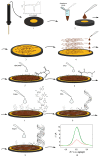Functional Nanomaterials Enhancing Electrochemical Biosensors as Smart Tools for Detecting Infectious Viral Diseases
- PMID: 37175186
- PMCID: PMC10180161
- DOI: 10.3390/molecules28093777
Functional Nanomaterials Enhancing Electrochemical Biosensors as Smart Tools for Detecting Infectious Viral Diseases
Abstract
Electrochemical biosensors are known as analytical tools, guaranteeing rapid and on-site results in medical diagnostics, food safety, environmental protection, and life sciences research. Current research focuses on developing sensors for specific targets and addresses challenges to be solved before their commercialization. These challenges typically include the lowering of the limit of detection, the widening of the linear concentration range, the analysis of real samples in a real environment and the comparison with a standard validation method. Nowadays, functional nanomaterials are designed and applied in electrochemical biosensing to support all these challenges. This review will address the integration of functional nanomaterials in the development of electrochemical biosensors for the rapid diagnosis of viral infections, such as COVID-19, middle east respiratory syndrome (MERS), influenza, hepatitis, human immunodeficiency virus (HIV), and dengue, among others. The role and relevance of the nanomaterial, the type of biosensor, and the electrochemical technique adopted will be discussed. Finally, the critical issues in applying laboratory research to the analysis of real samples, future perspectives, and commercialization aspects of electrochemical biosensors for virus detection will be analyzed.
Keywords: aptasensors; electrochemical (bio)sensors; functional nanomaterials; genosensors; hybrid nanostructures; immunosensors.
Conflict of interest statement
The author declares no conflict of interest.
Figures














Similar articles
-
Functional Nanomaterials and Nanostructures Enhancing Electrochemical Biosensors and Lab-on-a-Chip Performances: Recent Progress, Applications, and Future Perspective.Chem Rev. 2019 Jan 9;119(1):120-194. doi: 10.1021/acs.chemrev.8b00172. Epub 2018 Sep 24. Chem Rev. 2019. PMID: 30247026 Review.
-
Recent Advances in Electrochemical Sensing Strategies for Food Allergen Detection.Biosensors (Basel). 2022 Jul 9;12(7):503. doi: 10.3390/bios12070503. Biosensors (Basel). 2022. PMID: 35884306 Free PMC article. Review.
-
Electrochemical Biosensors Based on Carbon Nanomaterials for Diagnosis of Human Respiratory Diseases.Biosensors (Basel). 2022 Dec 22;13(1):12. doi: 10.3390/bios13010012. Biosensors (Basel). 2022. PMID: 36671847 Free PMC article. Review.
-
Electrochemical Biosensors for the Detection of Antibiotics in Milk: Recent Trends and Future Perspectives.Biosensors (Basel). 2023 Sep 1;13(9):867. doi: 10.3390/bios13090867. Biosensors (Basel). 2023. PMID: 37754101 Free PMC article. Review.
-
Electrochemical diagnostics of infectious viral diseases: Trends and challenges.Biosens Bioelectron. 2021 May 15;180:113112. doi: 10.1016/j.bios.2021.113112. Epub 2021 Mar 2. Biosens Bioelectron. 2021. PMID: 33706158 Free PMC article. Review.
Cited by
-
Recent Development and Application of "Nanozyme" Artificial Enzymes-A Review.Biomimetics (Basel). 2023 Sep 21;8(5):446. doi: 10.3390/biomimetics8050446. Biomimetics (Basel). 2023. PMID: 37754197 Free PMC article. Review.
-
Artificial-Intelligence Bio-Inspired Peptide for Salivary Detection of SARS-CoV-2 in Electrochemical Biosensor Integrated with Machine Learning Algorithms.Biosensors (Basel). 2025 Jan 28;15(2):75. doi: 10.3390/bios15020075. Biosensors (Basel). 2025. PMID: 39996977 Free PMC article.
-
The Role of Electrochemical Sensors in Enhancing HIV Detection.Curr HIV Res. 2025;23(1):2-13. doi: 10.2174/011570162X363311250206045837. Curr HIV Res. 2025. PMID: 39950463 Review.
-
Electrochemical (Bio)Sensors for Toxins, Foodborne Pathogens, Pesticides, and Antibiotics Detection: Recent Advances and Challenges in Food Analysis.Biosensors (Basel). 2025 Jul 21;15(7):468. doi: 10.3390/bios15070468. Biosensors (Basel). 2025. PMID: 40710117 Free PMC article. Review.
-
Not Only Graphene Two-Dimensional Nanomaterials: Recent Trends in Electrochemical (Bio)sensing Area for Biomedical and Healthcare Applications.Molecules. 2023 Dec 27;29(1):172. doi: 10.3390/molecules29010172. Molecules. 2023. PMID: 38202755 Free PMC article. Review.
References
-
- Domingo E., Holland J.J. RNA virus mutations and fitness for survival. Annu. Rev. Microbiol. 1997;51:151–178. - PubMed
Publication types
MeSH terms
LinkOut - more resources
Full Text Sources
Medical

